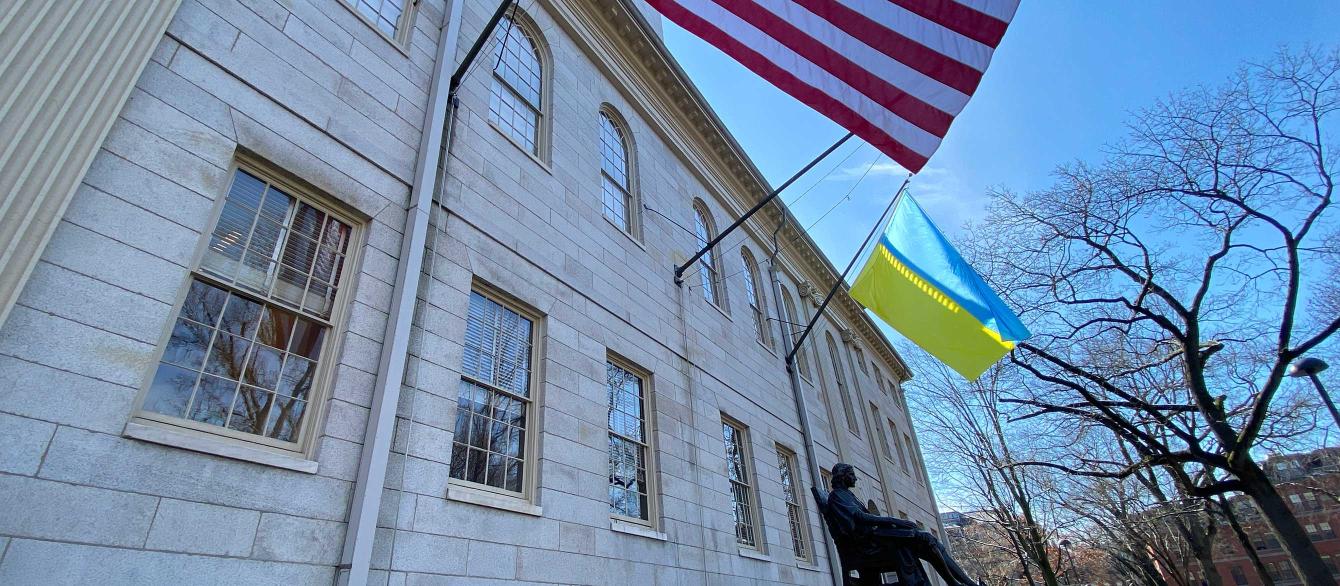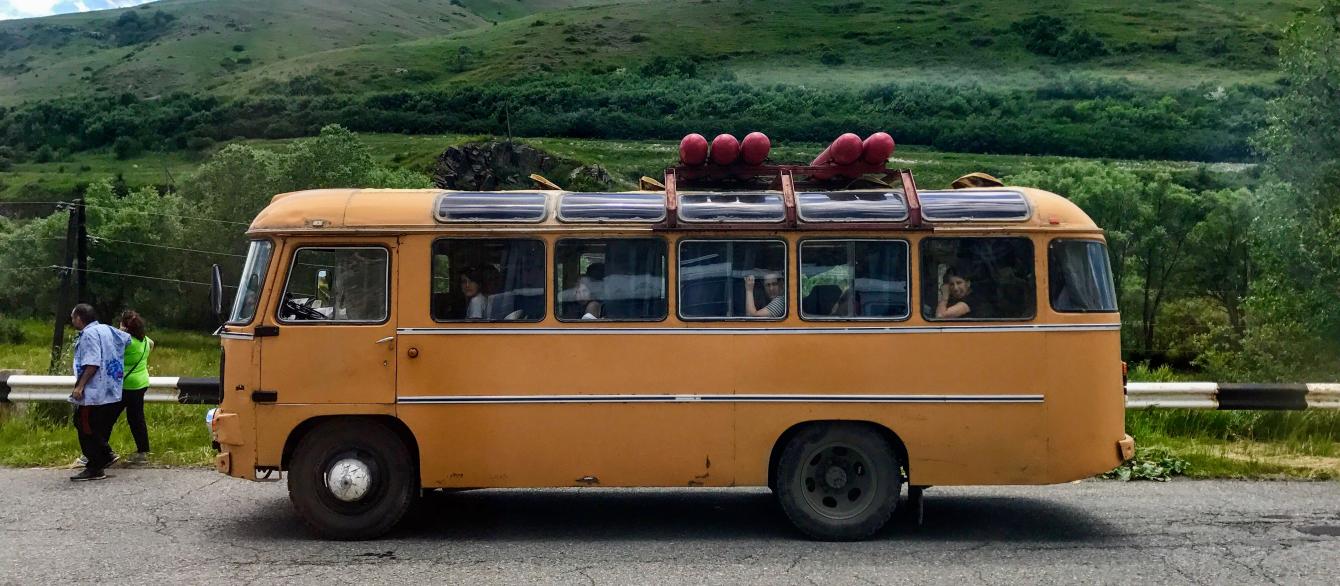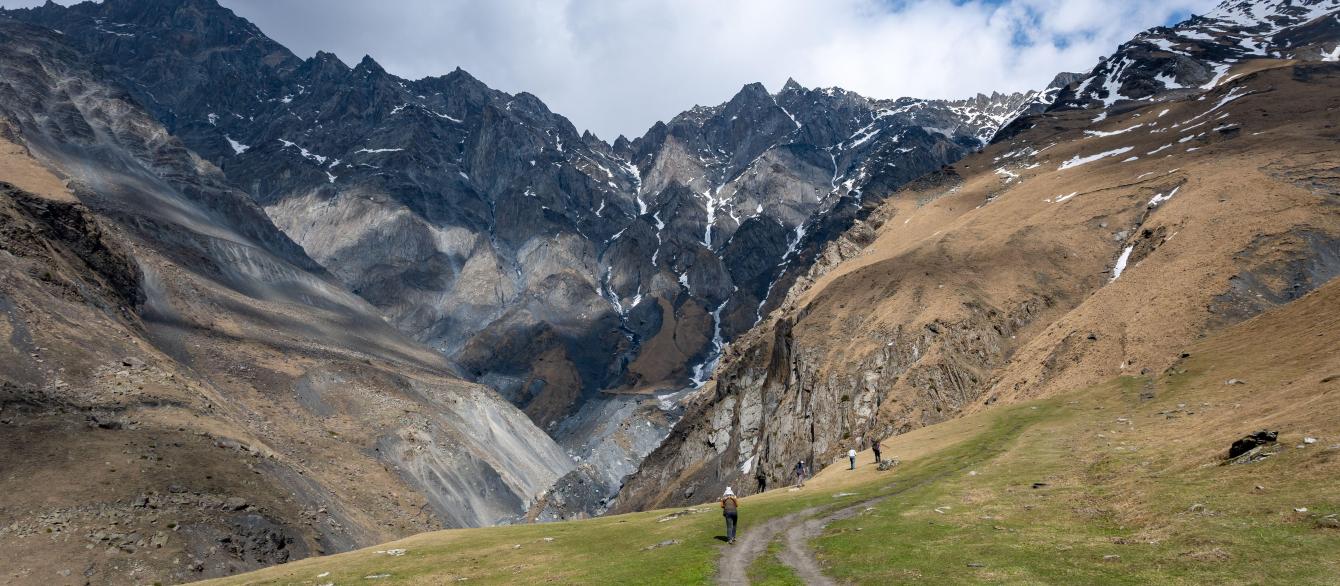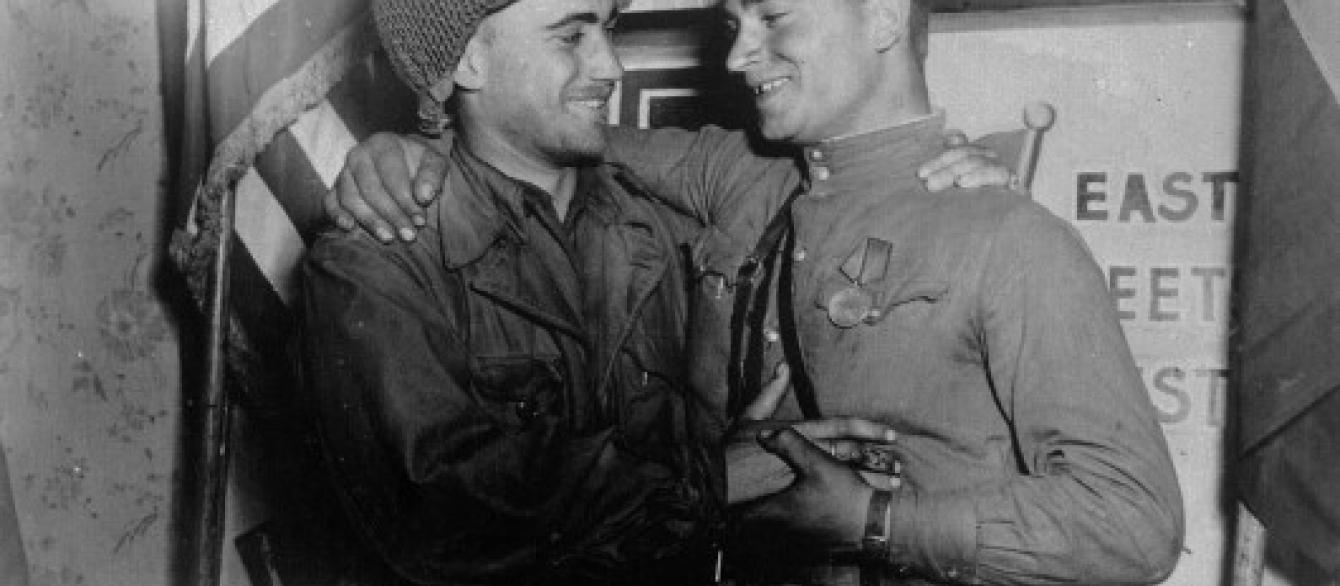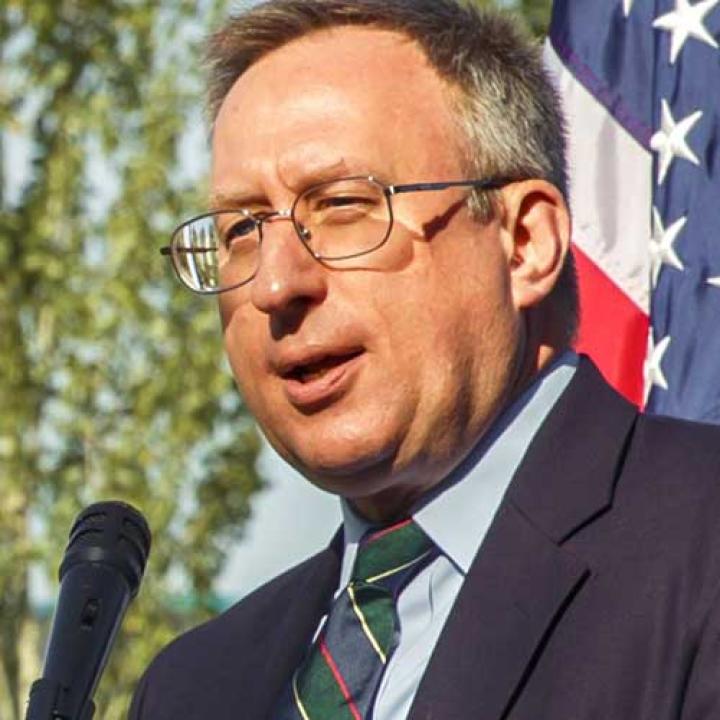Readers may recognize this photo of an American and a Soviet soldier embracing shortly after their meeting at the Elbe River at Torgau, Germany on April 25, 1945. They represented the historic coming together of American and Soviet armies that culminated in Germany’s surrender weeks later.
In 2005, as U.S. Ambassador to the former Soviet Republic of Belarus, I was looking for ways to commemorate the 60th anniversary of the end of World War II, a war that left its tragic mark on nearly every Belarusian family. I also wanted to improve America’s image among Belarusians in the midst of a hostile state media environment. Perusing a local Minsk newspaper, I found tucked away in the back pages a small item noting that the Soviet soldier in the famous photograph, Alexander Silvashko, lived in a remote village in Belarus. I immediately determined to meet him. With the quiet help of the Belarusian Veteran’s Association, my intrepid Belarusian assistant Paulina was able to contact Mr. Silvashko and set up a visit. Teaming up with the U.S. Defense Attaché, and with the help of Paulina and an embassy driver, we journeyed for what seemed like hours down narrow dirt roads to reach the little village of Morach and Silvashko’s modest apartment. Mr. Silvashko warmly welcomed us. He lived alone. His wife had died a few years before, and he had long retired as director of the village school where he also taught history. Over tea, Silvashko vividly recalled his meeting with the American soldier in the photo, Second Lieutenant Bill Robertson of the U.S. Army 69th Infantry Division.
As American armies advanced through Germany from the West and Soviet armies moved in from the East, Robertson’s intelligence unit was ordered to scout ahead. Hoping to be the first American to meet the Soviets, Robertson defied orders and drove far beyond his authorized five-kilometer perimeter to reach a bridge spanning the Elbe River at Torgau. Silvashko, a lieutenant in the Soviet army, had also reached the bridge on the Elbe’s eastern side. Silvashko saw a group of soldiers in strange uniforms on the other bank waving a white sheet painted with red stripes and a blue smudge. Never having seen an American flag or American soldiers, he thought the group could be Germans attempting to entice his unit across the half-destroyed bridge into an ambush. Silvashko ordered his men to lob a couple of shells at the group, scattering them. After a short time, Robertson and a few of his men returned to the bridge and with shouts, hand signals and the efforts of a Soviet POW they had earlier freed, urged the Soviet soldiers to come across and meet them half way. Silvashko sent his platoon sergeant Andreev across the fractured girders until he met Robertson and brought the Americans over to the Soviet side. Although Silvashko and Robertson could not understand each other’s language, with gestures they finally made out who they were. The Allies had finally united!
After a short, impromptu celebration with the Soviets, Robertson invited Silvashko to come with him to American headquarters. When Silvashko, along with Sergeant Andreev and two superior officers, arrived, the Americans feted them with food, drink and exchanges of insignia and wrist watches. A photographer snapped the famous photo. The next morning the Americans returned the Soviets to their lines where the two senior Soviet officers were promptly arrested, sent home, and stripped of their party membership (they were probably lucky that was the extent of their punishment.) Silvashko said he was too young and stupid to be punished, and besides, his unit was moving on to engage the Germans in more bloody fighting in Czechoslovakia (Sergeant Andreev died a week later in the battle for Prague.) Robertson, too, was arrested for disobeying orders, but was quickly released allegedly under General Eisenhower’s personal order.
After the war, Silvashko returned to his native Ukraine to find his family and his village wiped out. Army comrades from Belarus encouraged him to settle there in the small village of Morach where he spent the rest of his life. Robertson went on to study medicine and became a noted neurosurgeon in Los Angeles. Silvashko and Robertson did not see each again until 1975, when détente between the United States and the Soviet Union brought them back together in Moscow to commemorate the 30th anniversary of their meeting on the Elbe. Silvashko also showed us photos of a subsequent visit by Robertson and other Americans from the historic meeting on the Elbe, who traveled to Morach together with their spouses.
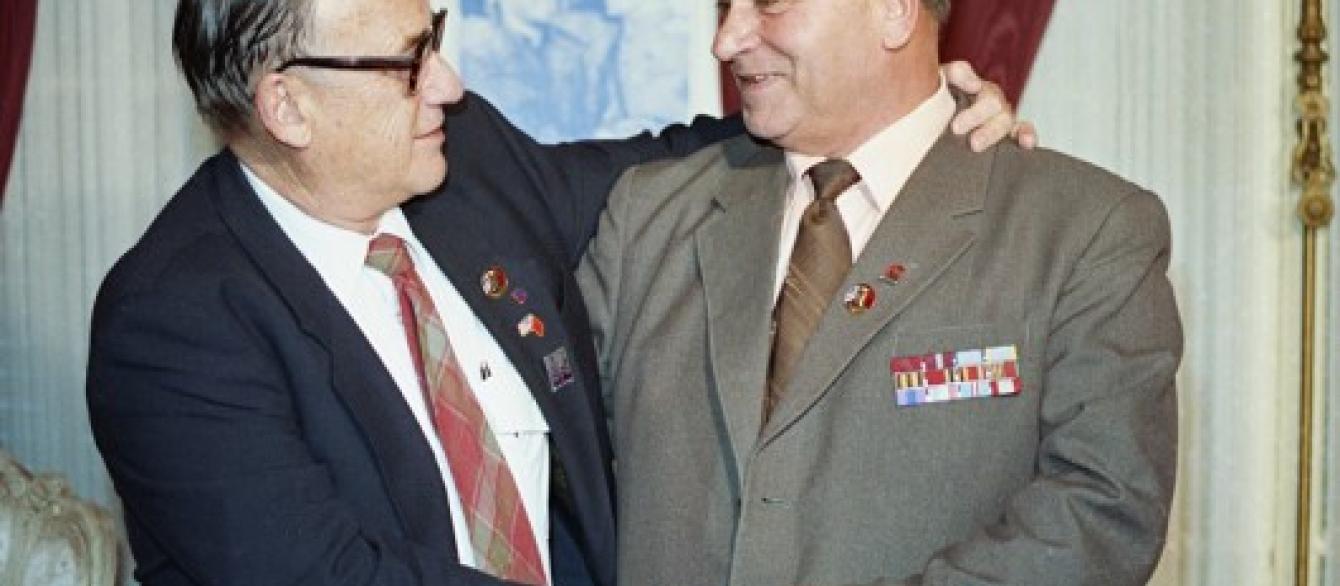
Bill Robertson and Alexander Silvashko meet after 30 years in Moscow 1975.
Shortly after our visit, our embassy Public Affairs section sent a team down to Morach to interview Alexander Silvashko. The interview became the centerpiece of a film our embassy produced entitled, “The History of a Handshake.” We were able to unveil the film to the Belarusian public in time for the Victory Day commemorations. The Russian language film can be viewed online and Robertson’s account of the meeting, recorded in 1989, can be heard here.
Public reaction was overwhelmingly positive. Even the Belarusian government, with which we were not on the best of terms, indicated tacit approval. Watching the film brought tears to the eyes of many viewers. It still brings tears to my eyes. In subsequent ambassadorships to Uzbekistan and Kazakhstan, I gave copies of the film to my Belarusian, local, and even Russian counterparts, who told me how deeply it moved them and their staffs.
A few months after we made the film, we invited Silvashko to Minsk to retell his personal tale of the meeting of American and Soviet soldiers to a group of visiting West Point cadets, along with fellow cadets from the Belarusian Military Academy. He overwhelmed them. I recall Silvashko’s beaming face as American and Belarusian cadets reenacted the famous handshake in front of him. Before we drove Silvashko back home to Morach, the Belarusian Defense Ministry invited him to lay flowers at the Eternal Flame Memorial in Minsk’s Victory Square. At the Square, the Ministry had assembled the full honor guard regiment as if for a head of state, as Silvashko, who up to then had lived largely in obscurity, laid his simple wreath. The Defense Ministry later told our Defense Attaché how our embassy’s respect and attention to this simple veteran had impressed them. In a way, Silvashko had brought allies back together again.
Although Bill Robertson died years before in 1999, Alexander Silvashko never forgot his friend. I will never forget Mr. Silvashko. He survived a brutal war and a harsh post-war life. He told us with a wry smile that until 1975 his meeting the Americans in 1945 was dangerous to talk about or even acknowledge. As it was, the authorities had relegated him to teaching school after removing him from his position as a kolkhoz director for refusing to follow Krushchev’s misguided directive to plant corn in Belarus’s unsuitable conditions.
Many times Silvashko said, if only the comradeship American and Soviet GIs enjoyed during those fleeting days in 1945 had endured, what a different and better world it might have been. Alexander Silvashko died a few years ago. May he rest in peace along with his friend Bill Robertson. Their historic meeting still inspires and perhaps saddens us to think about what could have been, but 75 years later, it also demonstrates how shared memories can help bridge modern divisions.

